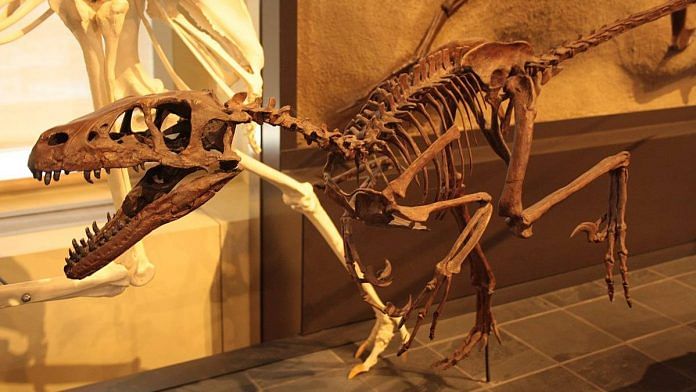New Delhi: Scientists, using advanced nuclear imaging techniques, have confirmed that a 93-million-year-old crocodile, whose fossil was found in Australia, devoured a juvenile dinosaur. The conclusions were made based on remains found in the fossilised stomach contents of the crocodile.
The discovery of the fossil in 2010 was made by the Australian Age of Dinosaurs Museum, in association with the University of New England. The crocodile was about 2 to 2.5 meters in length. It was found in a massive, shattered boulder.
Early neutron imaging scans of one rock fragment from the boulder detected bones of the small chicken-sized juvenile dinosaur in the gut. The species of the dinosaur is yet to be formally identified.
The dinosaur bones were entirely embedded within the dense ironstone rock. Investigators think it is likely that the crocodile was caught up in a megaflood event, was buried and died suddenly. Read more.
Also read: ISRO successfully launches new earth observation satellite in 2022’s first launch
Lichens threatened by climate change
Lichens are composite living structures, comprising of algae and fungus, and are a major food source for reindeers. However, a new study warns that these symbiotic structures are unable to adapt quickly to changing climate, and many are likely to get wiped out.
Researchers from Chicago’s Field Museum found that the predicted rate of modern climate change vastly exceeds the rate at which algae have evolved in the past. This means that certain parts of where they are found today are likely to become inhospitable in the future.
The researchers examined an algae called Trebouxia for the study. When this algae takes up residence inside a lichen, they live together with the fungus as one. The fungus provides the physical structure, while the algae provide food through photosynthesis.
There are more than 7,000 kinds of lichen powered by Trebouxia, making it the most common algal partner in lichens. If the Earth continues warming at the rates predicted, it’ll be too hot for many Trebouxia species in parts of their ranges, and this could have impact on other organisms.
The team determined that it could take hundreds of thousands of years for Trebouxia to adapt to the temperature changes that we’re on course to see in the next century.
This does not mean that the 7,000 Trebouxia lichens are all destined for extinction. The scientists think the change in climate could influence how algae interact with fungi in the future.
Losing lichens could have a profound effect on their ecosystems. Lichens are the dominant vegetation on seven per cent of the Earth’s surface. They play roles in ecosystem by retaining moisture, playing a part in carbon and nitrogen cycling, and some of them are used by animals for food or nesting materials. Read more.
NASA probe beams back X-ray image of exploding star
NASA’s Imaging X-Ray, Polarimetry Explorer — which was launched in December last year — has delivered its first image this week — remains of a star that exploded in the 17th century.
The shock waves from the explosion of Cassiopeia A had swept up surrounding gas, heating it to high temperatures and accelerating cosmic ray particles to make a cloud that glows in X-ray light. Other telescopes have studied Cassiopeia A before, but IXPE will allow researchers to examine it in a new way.
A key measurement that scientists will make with IXPE is called polarisation, a way of looking at how X-ray light is oriented as it travels through space. The polarisation of light contains clues to the environment where the light originated. IXPE’s instruments also measure the energy, the time of arrival, and the position in the sky of the X-rays from cosmic sources.
With polarisation data from Cassiopeia A, IXPE will allow scientists to see, for the first time, how the amount of polarisation varies across the supernova remnant, which is about 10 light-years in diameter. Researchers are currently working with the data to create the first-ever X-ray polarisation map of the object. Read more.
‘Heading’ football may change blood patterns in brain
A new study shows that repeated ‘heading’ in football — the act of hitting the ball with one’s head — can cause changes in the blood patterns inside a player’s brain, potentially interfering with signalling pathways.
In a study conducted among football players in Norway, researchers, led by Stian Bahr Sandmo of the Oslo Sports Trauma Research Centre at the Norwegian School of Sport Sciences, discovered specific alterations in levels of microRNAs in the brain. The team analysed blood samples from 89 professional players in Norway.
Blood samples taken from players after head impacts in matches showed specific changes in certain microRNA levels, whose numbers were unaffected by the other high-intensity exercise.
Accidental head injuries were found to alter the levels of eight microRNAs. Researchers suggest that microRNAs may also be able to differentiate injury severity. Read more.
Also read: Mixed-race US woman becomes first to be cured of HIV using new cord blood treatment



